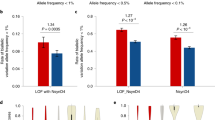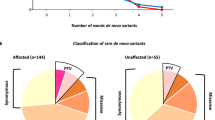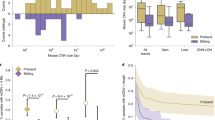Abstract
Autosomal genetic variation is presumed equivalent in males and females and makes a major contribution to disease risk. We set out to identify whether maternal copy number variants (CNVs) contribute to autism spectrum disorders (ASDs). Surprisingly, we observed a higher autosomal burden of large, rare CNVs in females in the population, reflected in, but not unique to, ASD families. Meta-analysis across control data sets confirms female excess in CNV number (P=2.1 × 10−5) and gene content (P=4.1 × 10−3). We additionally observed CNV enrichment in ASD mothers compared with control mothers (P=0.03). We speculate that tolerance for CNV burden contributes to decreased female fetal loss in the population and that ASD-specific maternal CNV burden may contribute to high sibling recurrence. These data emphasize the need for study of familial CNV risk factors in ASDs and the requirement of sex-matched comparisons.
This is a preview of subscription content, access via your institution
Access options
Subscribe to this journal
Receive 12 print issues and online access
$259.00 per year
only $21.58 per issue
Buy this article
- Purchase on Springer Link
- Instant access to full article PDF
Prices may be subject to local taxes which are calculated during checkout


Similar content being viewed by others
References
Stankiewicz P, Lupski JR . Structural variation in the human genome and its role in disease. Annu Rev Med 2010; 61: 437–455.
Stein JL, Parikshak NN, Geschwind DH . Rare Inherited variation in autism: beginning to see the forest and a few trees. Neuron 2013; 77: 209–211.
Hehir-Kwa JY, Pfundt R, Veltman JA, de Leeuw N . Pathogenic or not? Assessing the clinical relevance of copy number variants. Clin Genet 2013; 84: 415–421.
Girirajan S, Rosenfeld JA, Coe BP, Parikh S, Friedman N, Goldstein A et al. Phenotypic heterogeneity of genomic disorders and rare copy-number variants. N Engl J Med 2012; 367: 1321–1331.
Jacquemont S, Coe BP, Hersch M, Duyzend MH, Krumm N, Bergmann S et al. A higher mutational burden in females supports a "female protective model" in neurodevelopmental disorders. Am J Hum Genet 2014; 94: 415–425.
Glessner JT, Coe BP, Hersch M, Duyzend MH, Krumm N, Bergmann S et al. Autism genome-wide copy number variation reveals ubiquitin and neuronal genes. Nature 2009; 459: 569–573.
Sanders SJ, Ercan-Sencicek AG, Hus V, Luo R, Murtha MT, Moreno-De-Luca D et al. Multiple recurrent de novo CNVs, including duplications of the 7q11.23 Williams syndrome region, are strongly associated with autism. Neuron 2011; 70: 863–885.
Pinto D, Pagnamenta AT, Klei L, Anney R, Merico D, Regan R et al. Functional impact of global rare copy number variation in autism spectrum disorders. Nature 2010; 466: 368–372.
Conrad DF, Pinto D, Redon R, Feuk L, Gokcumen O, Zhang Y et al. Origins and functional impact of copy number variation in the human genome. Nature 2010; 464: 704–712.
Abecasis GR, Auton A, Brooks LD, DePristo MA, Durbin RM, Handsaker RE, The 1000 Genomes Project Consortium. An integrated map of genetic variation from 1,092 human genomes. Nature 2012; 491: 56–65.
Croen LA, Braunschweig D, Haapanen L, Yoshida CK, Fireman B, Grether JK et al. Maternal mid-pregnancy autoantibodies to fetal brain protein: the early markers for autism study. Biol Psychiatry 2008; 64: 583–588.
Tsang KM, Croen LA, Torres AR, Kharrazi M, Delorenze GN, Windham GC et al. A genome-wide survey of transgenerational genetic effects in autism. PLoS One 2013; 8: e76978.
Weiss LA, Shen Y, Korn JM, Arking DE, Miller DT, Fossdal R et al. Association between microdeletion and microduplication at 16p11.2 and autism. N Engl J Med 2008; 358: 667–675.
Krumm N, O'Roak BJ, Karakoc E, Mohajeri K, Nelson B, Vives L et al. Transmission disequilibrium of small CNVs in simplex autism. Am J Hum Genet 2013; 93: 595–606.
Lundström S, Chang Z, Råstam M, Gillberg C, Larsson H, Anckarsäter H et al. Autism spectrum disorders and autistic like traits: similar etiology in the extreme end and the normal variation. Arch Gen Psychiatry 2012; 69: 46–52.
Robinson EB, Koenen KC, McCormick MC, Munir K, Hallett V, Happé F et al. A multivariate twin study of autistic traits in 12-year-olds: testing the fractionable autism triad hypothesis. Behav Genet 2012; 42: 245–255.
Rosenberg RE, Law JK, Yenokyan G, McGready J, Kaufmann WE, Law PA et al. Characteristics and concordance of autism spectrum disorders among 277 twin pairs. Arch Pediatr Adolesc Med 2009; 163: 907–914.
Ritvo ER, Freeman B, Mason-Brothers A, Mo A, Ritvo A . Concordance for the syndrome of autism in 40 pairs of afflicted twins. Am J Psychiatry 1985; 142: 74–77.
Robinson EB, Koenen KC, McCormick MC, Munir K, Hallett V, Happé F et al. Evidence that autistic traits show the same etiology in the general population and at the quantitative extremes (5%, 2.5%, and 1%). Arch Gen Psychiatry 2011; 68: 1113–1121.
Ronald A, Hoekstra RA . Autism spectrum disorders and autistic traits: a decade of new twin studies. Am J Med Genet B Neuropsychiatr Genet 2011; 156B: 255–274.
Hallmayer J, Cleveland S, Torres A, Phillips J, Cohen B, Torigoe T et al. Genetic heritability and shared environmental factors among twin pairs with autism. Arch Gen Psychiatry 2011; 68: 1095–1102.
Steffenburg S, Gillberg C, Hellgren L, Andersson L, Gillberg IC, Jakobsson G et al. A twin study of autism in Denmark, Finland, Iceland, Norway and Sweden. J Child Psychol Psychiatry 1989; 30: 405–416.
Sebat J, Lakshmi B, Malhotra D, Troge J, Lese-Martin C, Walsh T et al. Strong association of de novo copy number mutations with autism. Science 2007; 316: 445–449.
Marshall CR, Noor A, Vincent JB, Lionel AC, Feuk L, Skaug J et al. Structural variation of chromosomes in autism spectrum disorder. Am J Hum Genet 2008; 82: 477–488.
O’Roak BJ, Deriziotis P, Lee C, Vives L, Schwartz JJ, Girirajan S et al. Exome sequencing in sporadic autism spectrum disorders identifies severe de novo mutations. Nat Genet 2011; 43: 585–589.
Sanders SJ, Murtha MT, Gupta AR, Murdoch JD, Raubeson MJ, Willsey AJ et al. De novo mutations revealed bywhole-exome sequencing are strongly associated with autism. Nature 2012; 485: 237–241.
Iossifov I, Ronemus M, Levy D, Wang Z, Hakker I, Rosenbaum J et al. De novo gene disruptions in children on the autistic spectrum. Neuron 2012; 74: 285–299.
O’Roak BJ, Vives L, Girirajan S, Karakoc E, Krumm N, Coe BP et al. Sporadic autism exomes reveal a highly interconnected protein network of de novo mutations. Nature 2012; 485: 246–250.
Neale BM, Kou Y, Liu L, Ma'ayan A, Samocha KE, Sabo A et al. Patterns and rates of exonic de novo mutations in autism spectrum disorders. Nature 2012; 485: 242–245.
Acknowledgements
We acknowledge Drs Don Conrad, Jane Gitschier, Noah Zaitlen, Erika Yeh, Ousseny Zerbo and Vincent Yau for helpful discussion, Dr Ye Cheng for CNV calling in the AGRE data set and Kathryn Tsang for population comparisons based on SNP data. We thank all families who participated in and contributed to the studies and the public resources that we have used in these studies. We gratefully acknowledge the resources provided by the Autism Genetic Resource Exchange (AGRE) Consortium, the Simons Simplex Collection (SSC) and the participating families. We acknowledge funding sources R01 ES016669 (Croen), R21 HD065273 (Weiss), SFARI 136720 (Weiss) as well as IMHRO and UCSF-REAC support (to Weiss).
Author information
Authors and Affiliations
Corresponding author
Ethics declarations
Competing interests
The authors declare no conflict of interest.
Additional information
Supplementary Information accompanies the paper on the Molecular Psychiatry website
Supplementary information
PowerPoint slides
Rights and permissions
About this article
Cite this article
Desachy, G., Croen, L., Torres, A. et al. Increased female autosomal burden of rare copy number variants in human populations and in autism families. Mol Psychiatry 20, 170–175 (2015). https://doi.org/10.1038/mp.2014.179
Received:
Revised:
Accepted:
Published:
Issue Date:
DOI: https://doi.org/10.1038/mp.2014.179
This article is cited by
-
Rare copy number variants in males and females with childhood attention-deficit/hyperactivity disorder
Molecular Psychiatry (2023)
-
Chromosomal microarray analysis of 410 Han Chinese patients with autism spectrum disorder or unexplained intellectual disability and developmental delay
npj Genomic Medicine (2022)
-
A profile and review of findings from the Early Markers for Autism study: unique contributions from a population-based case–control study in California
Molecular Autism (2021)
-
Molecular omics resources should require sex annotation: a call for action
Nature Methods (2021)
-
The Female Autism Phenotype and Camouflaging: a Narrative Review
Review Journal of Autism and Developmental Disorders (2020)



